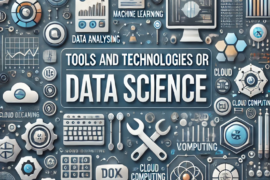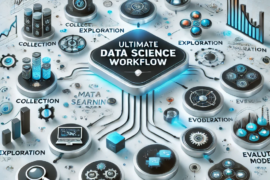Breaking into the field of data science as a fresh graduate can feel like a daunting task. However, with the right preparation and strategy, you can confidently navigate the interview process and secure your dream role. This guide, designed for TutorialsCache.com, provides actionable advice, essential resources, and a comprehensive list of interview questions to help you succeed.
What Does a Data Scientist Do?
Before diving into preparation, it’s important to understand what a data scientist does. Typical roles in data science include:
• Data Analyst: Focuses on interpreting data to provide actionable insights.
• Machine Learning Engineer: Builds and deploys machine learning models.
• Data Engineer: Develops pipelines and infrastructure for data processing.
• Business Intelligence Specialist: Analyzes business data to drive decision-making.
Understanding these roles will help you target the right opportunities and prepare accordingly.
Step-by-Step Guide to Cracking a Data Science Interview
1. Master the Fundamentals
A strong foundation in data science basics is crucial for success. Focus on:
• Mathematics: Topics like linear algebra, statistics, and probability are the backbone of data science.
• Programming: Learn Python or R for data manipulation and analysis.
• SQL: Understand how to query databases and manage data efficiently.
• Data Visualization: Practice using tools like Tableau, Power BI, or Matplotlib.
• Machine Learning: Study algorithms like decision trees, random forests, and neural networks.
2. Build a Standout Portfolio
Employers look for candidates who can demonstrate their skills with real-world projects. Include projects like:
• Predictive modeling (e.g., sales forecasting)
• Time series analysis
• Natural Language Processing (e.g., sentiment analysis)
• Exploratory Data Analysis (EDA) with compelling visualizations
Host your projects on GitHub or create a professional website to showcase your work.
3. Prepare for Technical Interviews
Technical interviews often test your theoretical knowledge and practical problem-solving skills. Focus on:
• Data Cleaning and Preprocessing: Handling missing data and outliers.
• Algorithm Understanding: Explaining the working of algorithms like k-means clustering or logistic regression.
• Evaluation Metrics: Knowing when to use accuracy, precision, recall, and F1-score.
Practice coding challenges on platforms like:
• LeetCode
• Kaggle
4. Learn Behavioral Interview Strategies
Data science roles often require collaboration and effective communication. Be prepared for behavioral questions like:
• “Describe a time you worked on a team project.”
• “How do you prioritize tasks when working on multiple projects?”
• “Explain a challenging situation and how you resolved it.”
Use the STAR method (Situation, Task, Action, Result) to structure your answers.
5. Study Domain-Specific Applications
Tailor your preparation based on the industry of the company you’re interviewing with:
• Healthcare: Predictive analytics and patient outcome forecasting.
• Finance: Fraud detection and risk modeling.
• Retail: Recommendation systems and customer segmentation.
6. Stay Updated with Trends
Data science evolves rapidly, so stay informed by:
• Reading blogs like Towards Data Science and KDnuggets.
• Following AI/ML advancements.
• Exploring books such as Introduction to Statistical Learning and Python for Data Analysis.
7. Craft an Impressive Resume
Your resume should highlight:
• Technical skills: Python, SQL, and machine learning frameworks.
• Projects: Include metrics that demonstrate the impact of your work.
• Certifications: Showcase relevant courses from platforms like Coursera and edX.
Additionally here are 30 Popular Data Science Interview Questions with Answers to Crack Data Science Interview
General Questions
1. What is data science, and how is it different from data analytics?
•Answer: Data science is an interdisciplinary field that uses algorithms, machine learning, and statistical methods to extract insights and build predictive models from data. Data analytics, on the other hand, focuses on analyzing existing data to provide actionable insights and solve specific business problems.
2. Explain the lifecycle of a data science project.
Answer: The typical lifecycle includes:
•Problem definition: Understand the business question.
•Data collection: Gather relevant data.
•Data preprocessing: Clean and format the data.
•Exploratory Data Analysis (EDA): Identify patterns and insights.
•Model building: Select and train algorithms.
•Evaluation: Assess model performance.
•Deployment: Implement the model in production.
•Monitoring: Continuously check model accuracy.
3. What are the types of machine learning, and when would you use each?
Answer: The three main types are:
•Supervised Learning: When labeled data is available (e.g., fraud detection).
•Unsupervised Learning: When data is unlabeled (e.g., customer segmentation).
•Reinforcement Learning: When an agent learns by interacting with an environment (e.g., robotics).
4. What is overfitting, and how do you address it?
Answer: Overfitting occurs when a model learns the noise in training data instead of the pattern, performing poorly on unseen data. Solutions include:
•Using simpler models.
•Applying regularization techniques (e.g., L1, L2).
•Increasing training data.
•Cross-validation.
5. Describe the bias-variance tradeoff.
Answer: The bias-variance tradeoff refers to the balance between:
•Bias: Error due to overly simplistic models.
•Variance: Error due to overly complex models.
Optimal performance is achieved by minimizing both bias and variance.
Mathematics and Statistics
6. What is the central limit theorem?
Answer: The central limit theorem states that the sampling distribution of the sample mean approaches a normal distribution as the sample size increases, regardless of the population’s distribution.
7. Explain the difference between correlation and covariance.
Answer:
•Correlation: Measures the strength and direction of the relationship between two variables (scaled between -1 and 1).
•Covariance: Measures how two variables vary together (unscaled).
8. What is a p-value, and what does it signify?
Answer: The p-value indicates the probability of observing results at least as extreme as those in the sample, assuming the null hypothesis is true. A small p-value (<0.05) suggests rejecting the null hypothesis.
9. Define Type I and Type II errors.
Answer:
•Type I Error: Rejecting a true null hypothesis (false positive).
•Type II Error: Failing to reject a false null hypothesis (false negative).
10. What is a normal distribution?
Answer: A normal distribution is a bell-shaped curve that is symmetric around the mean. It is characterized by the mean and standard deviation and is commonly used in statistics for probability distribution.
Programming and Tools
11. How would you optimize a Python script for efficiency?
Answer:
•Use efficient data structures (e.g., NumPy arrays).
•Avoid redundant calculations.
•Use libraries like NumPy or Pandas for vectorized operations.
•Profile the code with tools like cProfile.
12. What is the difference between Pandas and NumPy?
Answer:
•Pandas: Provides data manipulation tools for tabular data (DataFrames).
•NumPy: Offers high-performance mathematical operations for arrays.
13. How do you join two datasets in SQL?
Answer: Use SQL JOIN operations:
•INNER JOIN: Returns rows with matching values in both datasets.
•LEFT JOIN: Returns all rows from the left dataset and matching rows from the right dataset.
•RIGHT JOIN: Returns all rows from the right dataset and matching rows from the left dataset.
•FULL OUTER JOIN: Returns all rows from both datasets, with NULLs where matches are not found.
14. Describe a time when you used a data visualization tool to explain results.
Answer: Share an example where you used visualizations (e.g., bar charts, heatmaps) to communicate insights, such as identifying customer purchase trends using Matplotlib or Tableau.
Machine Learning
15. How do you decide which machine learning algorithm to use for a problem?
Answer: It depends on:
•Data type (structured, unstructured).
•Problem type (classification, regression, clustering).
•Dataset size.
•Interpretability and computational constraints.
16. Explain the confusion matrix and its metrics.
Answer: The confusion matrix is a table used to evaluate classification models:
•True Positives (TP): Correctly predicted positives.
•True Negatives (TN): Correctly predicted negatives.
•False Positives (FP): Incorrectly predicted positives.
•False Negatives (FN): Incorrectly predicted negatives.
Metrics:
•Precision = TP / (TP + FP)
•Recall = TP / (TP + FN)
•F1-Score = 2 × (Precision × Recall) / (Precision + Recall)
17. What is the difference between bagging and boosting?
Answer:
•Bagging: Combines predictions from multiple independent models (e.g., Random Forest).
•Boosting: Sequentially improves weak models by focusing on misclassified samples (e.g., Gradient Boosting).
18. How does a decision tree work?
Answer: A decision tree splits data into subsets based on feature values to make predictions. Splits are determined by measures like Gini impurity or information gain.
19. Explain k-means clustering.
Answer: K-means clustering partitions data into k clusters by:
•Assigning each data point to the nearest centroid.
•Updating centroids as the mean of assigned points.
•Repeating until convergence.
Practical Scenarios
20. Walk me through a data science project you’ve worked on.
Answer: Outline a project you’ve completed, focusing on:
•Problem statement.
•Data collection and preprocessing.
•Model building and evaluation.
•Key results and impact.
21. How would you build a recommendation system for an e-commerce platform?
Answer: Use:
•Collaborative filtering: Based on user-item interactions.
•Content-based filtering: Based on item features.
•Hybrid approaches: Combine both methods.
22. How would you handle missing data in a dataset?
Answer:
•Remove rows with missing values (if minimal).
•Impute values (e.g., mean, median, or mode).
•Use algorithms that handle missing data (e.g., XGBoost).
23. Suppose you have a dataset with thousands of features. How would you select the most relevant ones?
Answer:
•Use feature selection techniques like recursive feature elimination (RFE).
•Apply dimensionality reduction methods (e.g., PCA).
•Analyze feature importance from models (e.g., Random Forest).
24. How do you ensure that a model you built is not biased?
Answer:
•Use balanced datasets.
•Perform stratified sampling.
•Regularly monitor performance on diverse test datasets.
Advanced Questions
25. What is the role of dimensionality reduction in machine learning?
Answer: It reduces the number of features while retaining essential information, improving model performance and reducing overfitting.
26. Explain the working of a neural network in simple terms.
Answer: Neural networks mimic the human brain, consisting of layers of nodes (neurons) connected by weights. Input data passes through layers, applying transformations and weights to produce an output.
27. What are the advantages of ensemble methods in machine learning?
Answer:
•Improved accuracy.
•Reduced overfitting.
•Better generalization.
28. How do you deploy a machine learning model in production?
Answer:
•Package the model using tools like Flask or FastAPI.
•Deploy on cloud platforms (e.g., AWS, Azure).
•Monitor performance with logging and analytics.
29. What is the importance of cross-validation in model evaluation?
Answer: Cross-validation splits data into multiple training and validation sets, providing a robust estimate of model performance and preventing overfitting.
30. Describe a scenario where you used unsupervised learning to solve a problem.
Answer: For example, using clustering to segment customers based on purchase behavior, helping businesses create targeted marketing strategies.
By mastering these questions and their answers, you’ll be well-prepared to tackle data science interviews confidently.
Thanks for reading this article, You can also read previous articles about Tools for Datascience.
Good Luck for your interviews, Always share your experiences.




Comments are closed.